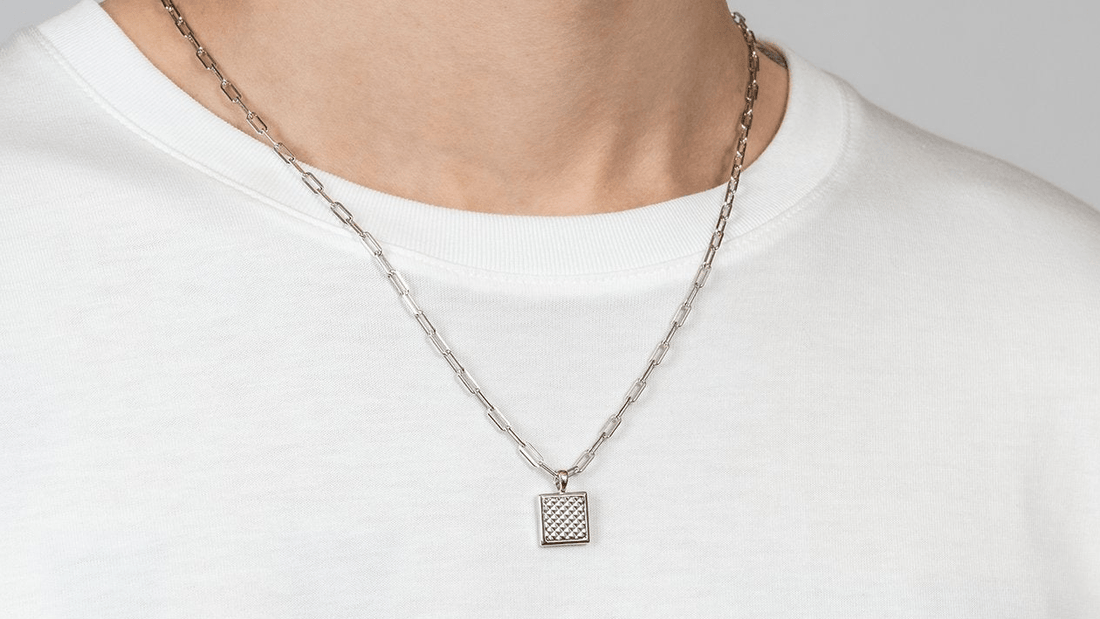ネックレスはどんな装いもワンランクアップさせる、時代を超えたアクセサリーです。そして、それは女性だけのものではありません。この総合ガイドでは、男性(そしてあらゆるジュエリー愛好家)がネックレスについて知っておくべきことをすべて網羅しています。適切なスタイルや長さの選び方からお手入れ方法まで、よくある質問に、親しみやすく的確にお答えします。メンズネックレスコレクションをご覧になる方も、素敵なギフトをお探しの方も、このガイドは自信を持ってお選びいただくためのお手伝いをいたします。ご自身のスタイルや予算に合ったネックレスの選び方、男性がネックレスを身につけることに対する文化的認識、人気のスタイル(シルバーとゴールドの両方)、象徴性とギフトのアイデア、現在のトレンド、メンテナンスとケア、そしてあらゆるシーンに合わせたスタイリングのヒントについて解説します。ガイドを最後まで読んでいただければ、スタイリッシュに、そして気軽にネックレスを身につけ、楽しむ方法がわかるはずです。
目次
- 自分にぴったりのネックレスの選び方:スタイル、長さ、予算
- 文化的認識と年齢:ネックレスをつける男性
- 男性用ネックレスのスタイルと種類
- 象徴と贈り物:男性向けネックレスの意味
- メンズネックレスの歴史とトレンド
- ネックレスのメンテナンスとケア
自分にぴったりのネックレスの選び方:スタイル、長さ、予算
このセクションでは、あなたのスタイル、ネックライン、そして予算に合ったネックレスの選び方の基本をご紹介します。適切な長さの選び方から、素敵なペンダントやお手頃な素材の選び方まで、これらのよくある質問が購入の際の参考になります。男性向けのネックレスの選択肢はかつてないほど豊富になっています。その中から、あなたにぴったりのネックレスを見つけるための方法をご紹介します。
ネックレスの長さの選び方は?
適切なネックレスの長さを選ぶことは、快適さとスタイルの鍵となります。まず、ネックレスを胸のどこに置いたいかを考えてみましょう。男性によくあるチェーンの長さは18~22インチ(45~55cm)で、これは通常、首の付け根から胸の上部にかけての長さです。鎖骨にかけるネックレス(約20インチ)の場合は、首の周囲を測り、数インチ加えます。柔らかいテープか紐を希望の長さで首に巻き付け、その長さを測ります。ペンダントを追加する場合は、ペンダントがチェーンの長さよりも少し下になることを覚えておいてください。首の大きい男性やペンダントを低めにしたい方は、24インチ(60cm)以上を選ぶとよいでしょう。最終的には、個人の好みと服装との相性(例えば、クルーネックの上から着るか、Tシャツの上から着るか)によって最適な長さが決まります。一部のネックレスには調節可能なチェーンが付いており(Louis Faglin Carmen Necklace は最大 55 cm まで長さを調節可能)、さまざまなネックラインと外観に合わせてフィットを微調整できます。
ネックラインに合うネックレスの選び方は?
ネックレスをネックラインに合わせると、バランスの取れた印象になります。一般的に、短めのネックレスはオープンネックラインに、長めのネックレスはハイネックラインによく合います。
- Vネックやボタンを外したシャツを着ているなら、Vネックの少し上、またはVネックのラインに沿う長さ(約45~50cm)のネックレスがスタイリッシュに見えます。小さなペンダントが付いたチェーンネックレスは、胸元の開いた部分にしっくりと馴染みます。
- クルーネックやTシャツの場合は、シャツの上に重ねたり、シャツの上から垂らしたりできる、少し長めのチェーン(50~60cm)がおすすめです。シンプルなチェーンでも、大胆なペンダントでも、目立たせたいポイントに合わせて選べます。
- 襟付きシャツやボタンダウンシャツの場合、シャツの上からネックレスを着ける場合は、胸の真ん中あたりにくるミディアム丈のものを選びましょう。シャツの下にインするなら、襟元からほんの少し見えるくらいの(または襟の下で首に心地よくフィットする)短めのチェーンが理想的です。
- ハイネックやタートルネックのセーターには、ペンダント付きの長めのネックレス(24~30インチ)を合わせると、生地の上にスタイリッシュな印象を与えることができます。
ネックラインの開口部の幅を常に考慮してください。ネックレスは、競合したり、紛失したりすることなく、スペースをうまく埋める必要があります。
ge】Ariaネックレス+ペンダント(写真)のようなゴールドのペンダントネックレスは、様々なネックラインによく合います。Ariaは、55cmのチェーンに長方形のペンダントが付いており、鎖骨のすぐ下あたりにフィットします。クルーネックTシャツや開襟シャツと合わせても、胸元にアクセントを加えつつ、コーディネートを圧迫することなく、コーディネートを引き立てます。
かっこいいメンズネックレスペンダントにはどんなものがありますか?
男性用の「クール」なペンダントには様々なスタイルがあり、好みやどんな印象を与えたいかによって選び方が変わります。人気のペンダントは以下のとおりです。
- ドッグタグと ID プレート: 彫刻でパーソナライズできる、クラシックなミリタリー風の外観。
- 幾何学的なデザイン: 興味深い質感や彫刻が施されたモダンな形状 (バー、シールド、正方形など) が非常に流行しています。
- シンボルとアイコン:意味のあるシンボル(十字架、錨、矢印、動物のモチーフなど)は、あなたの個性や信念を表現するのに最適です。これらは流行に左右されず、ミニマルなものから精巧なものまで、幅広く取り入れることができます。
- 天然素材やビーズ:ボヘミアンやサーフスタイルにインスパイアされた雰囲気を演出するために、石や木、あるいは革を使ったペンダントを選ぶ男性もいます。シンプルな黒曜石の矢じりや木彫りのお守りは、カジュアルなスタイルにぴったりです。
ペンダントを選ぶときは、体格に応じたサイズ(フレームが大きい場合は大きいペンダント、控えめな印象の場合は小さいペンダント)と素材(ステンレス、シルバー、ゴールドなど)を考慮してください。
ge】ピラミッドペンダント(上の写真のシルバー)は、印象的なピラミッド模様が特徴で、質感と魅力を添えています。このような幾何学模様のペンダントは、ネックレスにモダンで建築的な雰囲気をもたらし、大胆なステートメントピースとして際立ちます。ルイ・ファグランのコレクションには、ヘリンボーンギョーシェ模様のシェブロンペンダントも含まれており、現代的なデザインを求める方にとって、他に類を見ない選択肢となります。
男性に最適な、手頃な価格のシルバーネックレスは何ですか?
シルバーネックレスは、お手頃価格とスタイリッシュなデザインを兼ね備えた素晴らしい選択肢です。スターリングシルバーは、純金よりも手頃な価格で高級感を演出します。お手頃価格のおすすめとしては、スターリングシルバーのチェーンや、クラシックなデザインのシルバーメッキのネックレスがおすすめです。以下におすすめをいくつかご紹介します。
- スターリングシルバーチェーン:シンプルなシルバーチェーン(カーブチェーンやフィガロチェーンなど)は、男性のワードローブの定番アイテムです。例えば、925スターリングシルバーのフィガロネックレスは、時代を超えたスタイルでありながら、お手頃価格を実現しています。シルバーのフィガロチェーンやカーブチェーンは耐久性があり、用途が広く、重量に応じて価格も手頃です。
- シルバーペンダント:小さなスターリングシルバーのペンダントが付いたネックレスは、とてもお手頃価格です。ミニマルなデザインや、金属の使用量が少ない小さめのペンダントを探して、価格を抑えましょう。ルイ・ファグランのシルバー製「グレイン・ドルジュ・ペンダント」は、エレガントでありながらお手頃価格のペンダントの一例です。独特のバーリーコーンギョーシェ模様が特徴で、ペンダントのみのアイテムなので、お手持ちのチェーンと組み合わせてもお手頃です。
- シルバートーンのステンレススチール:シルバートーンのメッキを施したステンレススチールのネックレスは、シルバーの外観を再現でき、通常はより手頃な価格です。また、変色しにくいため、メンテナンスの手間もかかりません。
ショッピングの際は、厳選されたメンズシルバーネックレスのセレクションをご覧ください。様々な価格帯のアイテムを取り揃えています。最高の価値を求めるなら、素材の品質(純銀は925スターリングシルバーが標準)と流行に左右されないクラシックなデザインに注目してください。お手頃価格だからといって、必ずしも退屈なアイテムとは限りません。シンプルな2~3mmのシルバーチェーンでも、スタイルを格上げできますし、後からペンダントトップを追加することも可能です。適切なお手入れ(銀を乾燥させ、磨くなど)をすれば、お手頃価格のシルバーネックレスでも何年も美しい輝きを放ちます。
メンズネックレスの選び方は?
メンズネックレスの選び方は、個人のスタイル、シーン、素材、そして意味合いといった重要な要素に絞られます。まずは、ご自身のスタイルとワードローブについて考えてみましょう。控えめなアクセサリーがお好みですか、それとも存在感のあるアクセサリーがお好みですか?保守的またはプロフェッショナルなスタイルなら、シルバーまたはゴールドのシンプルなチェーンがベストチョイスかもしれません。大胆なスタイルやトレンド感を求めるなら、存在感のあるペンダントや太めのチェーンのネックレスがおすすめです。
次に、着用シーンや着用方法を考えてみましょう。普段使いには、丈夫で汎用性の高いもの(ミディアムサイズのチェーンやカジュアルな服装に合うペンダントなど)が理想的です。特別なイベントや装いに合わせるなら、ネックレスを他のアイテムとコーディネートするのも良いでしょう。例えば、ゴールドトーンのペンダントをゴールドの腕時計のディテールと合わせたり、ブラックのレザーコードネックレスをラフな装いに合わせたりするのも良いでしょう。
素材は、美しさと快適さの両方において重要です。一般的な選択肢としては、スターリングシルバー、ゴールド(またはヴェルメイユのような金メッキ)、ステンレススチール、レザーコードなどがあります。シルバーとホワイトゴールドはクールで控えめな印象で、イエローゴールドはより存在感があり、温かみのある色合いです。金属アレルギーをお持ちの方や、アクティブなライフスタイルの方であれば、耐久性の面でステンレススチールやチタンが適しているかもしれません。
最後に、意味や個人的な好みについて考えてみましょう。好きなシンボルがあしらわれたペンダントや、プレゼントでもらったネックレスなど、個人的な思いを込めたネックレスを選ぶのも良いでしょう。例えば、音楽が趣味なら、小さなト音記号のペンダントは意味深い選択となるでしょう。流行に敏感でありながら、自分らしさも感じられるものをお探しなら、ルイ・ファグランの「マドリガル ネックレス + ペンダント」がおすすめです。音楽のハーモニーにインスパイアされた精巧な彫刻が施されており、音楽へのさりげないオマージュとエレガントなスタイルが融合しています。
まとめると、メンズネックレスの選び方は、自分の個性に合ったスタイル、体型やワードローブに合う長さ、予算とスタイルの両方に合う素材、そして自信を持って身に着けられるデザインを選ぶことです。ぜひ試着して、他のアクセサリーと重ね付けしてみてはいかがでしょうか。もしそれが「自分らしい」と感じられ、頻繁に身につけられると想像できるなら、それがまさにうってつけです!
男性用のユニークなシルバーネックレスはどこで買えますか?
男性向けの個性的なシルバーネックレスをお探しなら、メンズデザインに特化したジュエリーブランドやコレクションを探すのがおすすめです。一般的な量販店の商品ではなく、クリエイティブで高品質なネックレスが揃っています。個性的な一品を見つけるためのヒントをいくつかご紹介します。
- メンズジュエリーブランド:ルイ・ファグランなど、多くのブランドは男性向け、あるいはユニセックスなデザインを専門としており、男性の好みに合うスタイルを心がけています。そのようなブランドのウェブサイトでメンズネックレスのセクションを探してみることで、他では見られないユニークなデザインが見つかるかもしれません。例えば、ルイ・ファグランのフランス製ジュエリーは、独特のギョーシェ模様が特徴です。シルバーのピラミッドペンダントやグレインドルジェペンダントは、珍しいデザインの好例で、ネックレスを際立たせるでしょう。
- 職人によるジュエリーやブティックジュエリー:職人によるジュエリーやブティック(Etsyなどのオンラインマーケットプレイスや地元のクラフトジュエリーショップなど)を訪れてみてはいかがでしょうか。珍しいモチーフ、カスタム彫刻、あるいは様々な素材を組み合わせた手作りのシルバーネックレスを提供していることが多いです。これらの一点ものは、非常に個性的でユニークなものとなるでしょう。
- シルバージュエリーのコレクション:バラエティ豊かなアイテムをお探しなら、厳選されたメンズ向けシルバーネックレスのコレクションをご覧ください。小売店やブランド各社が、クラシックなチェーンからモダンなペンダントまで、幅広いシルバージュエリーを展示しています。テクスチャ加工のリンク、酸化(黒化)仕上げ、あるいはシルバーとレザーの組み合わせといったデザインディテールに注目して、個性的な一品を見つけてください。
- ヴィンテージやアンティークショップ:ヴィンテージ品を探すことで、ユニークな一品が見つかることもあります。アンティークのスターリングシルバーのメダリオンや、何十年も前のレトロなチェーンは、モダンな装いにクールで個性的なアクセントを加えてくれます。ただし、品質が良く、信頼できる販売者かどうかを確認しましょう。
ユニークな作品を購入する際は、本物であることと品質にもご留意ください。長くご愛用いただけるよう、本物のスターリングシルバー(通常は925の刻印)であることを確認してください。例えば、ルイ・ファグランの製品は、925シルバーまたは高品質のシルバーメッキ(ヴェルメイユ)を使用し、フランスで手作りされています。個性と職人技が融合した逸品です。結局のところ、お気に入りのスタイルと信頼できる製品を提供しているお店を選ぶのがベストです。じっくりと時間をかけてご覧いただければ、きっとあなた(あるいは贈る相手の男性)を魅了する、他にはないシルバーネックレスが見つかるはずです。
文化的認識と年齢:ネックレスをつける男性
メンズネックレスは、古代のシンボルから現代のファッションステートメントへと進化を遂げてきました。このセクションでは、なぜ今日、より多くの男性がネックレスを身につけているのか、そしてそれが何を意味するのかを探ります。文化的認識、世代交代、そして男性がネックレスを身につけることの個人的な意味についても触れていきます。これらの背景を踏まえることで、スタイルに性別や年齢の制限はないことを理解し、自信を持ってジュエリーを身につけることができるでしょう。
男性はなぜネックレスをつけているのでしょうか?
ファッションの規範が広がり、個人のスタイルが重視されるようになったため、男性がネックレスをつける機会はかつてないほど増えています。このトレンドにはいくつかの理由があります。
- ファッショントレンドとセレブの影響:近年、著名なミュージシャン、俳優、アスリートがネックレスを身につけている姿が頻繁に目撃されています。襟付きシャツから覗くゴールドチェーンから、Tシャツの上から重ね付けしたペンダントまで、様々なスタイルが見られます。こうした露出の増加により、ネックレスは男性的なアクセサリーとして定着しました。男性は、スタイルアイコンがネックレスを身につけているのを見て、自分も取り入れてみようという気持ちになるのです。
- 個性的なスタイルを表現:ネックレスは、比較的簡単に服装を個性的に見せる方法です。男性にとって、腕時計やブレスレットが昔から受け入れられてきたように、ネックレスは自己表現のキャンバスとなります。ミニマルなチェーンでも、存在感のあるペンダントでも、ネックレスを身につけることで、男性は自分の個性や趣味を少しだけ表現することができます(例えば、サーファーなら貝殻やビーズのネックレス、スピリチュアルな人は信仰のシンボルを身につけるなど)。
- 文化的・歴史的ルーツ:男性がネックレスを身につけることは、文化的に見て新しいことではありません。歴史を通して、そして様々な文化において、男性は地位、部族のアイデンティティ、宗教、あるいは身を守るためなど、様々な理由でネックレスを身につけてきました。古代の戦士がお守りを身につけていたり、首長が装飾的な首飾りをつけていたりしたことを思い浮かべてみてください。一部の文化では、男性が金のチェーンや宗教的なペンダントを身につけることは、何世紀にもわたって一般的でした。現代の男性がネックレスを身につけるのは、伝統への敬意を表してのことかもしれませんし、あるいは単にジュエリーは女性だけのものではないという認識が根付いているからかもしれません。
- ステレオタイプを打ち破る:現代の男性は、ファッションにおける古いジェンダーステレオタイプに縛られなくなっています。ネックレスなどのアクセサリーはユニセックスとして受け入れられるようになってきています。ファッション界におけるジェンダー規範の緩和に伴い、以前は「女性的」と見なされていたジュエリーを身につけることに抵抗を感じない男性が増えています。この変化は、男性がネックレスをクールだと感じれば、それを身につけるようになることを意味します。それ以上の正当化は必要ありません!
つまり、男性がネックレスをつけるのは、自ら望んでいるからであり、社会がよりオープンになったからでもあります。それはトレンド、自己表現、そして男性が自分を飾るという人類の伝統への回帰が融合した現象です。もしあなたがネックレスをつけようと考えているなら、それはきっと素晴らしい仲間がいるということです。それはあなたの外見をスタイリッシュに引き立て、世界にあなた自身を少しだけ伝える手段なのです。
男性がネックレスをつけるのはどういう意味ですか?
男性がネックレスを身につける場合、その「意味」は状況、ネックレスの種類、そしてその人自身によって大きく異なります。いくつかの解釈をご紹介します。
- 個人的な意味:男性のネックレスには、個人的な意味が込められていることがよくあります。特別な人からの贈り物、旅行の思い出、あるいは彼が大切にしているものの象徴(信仰の象徴である十字架、誰かを偲ぶチェーンの指輪、趣味や信念を象徴するペンダントなど)などです。この場合、ネックレスは、そこに込められた個人的な物語や感情を象徴するものです。
- ファッションステートメント:時には、単にスタイルセンスがあるというだけの場合もあります。ネックレスは、男性が外見の細部にまで気を配り、アクセサリーを身につけることをためらわないことを示している場合があります。例えば、チェーンを何本か重ね付けしたり、大ぶりのシルバーのペンダントを付けたりするのは、彼がファッションに敏感であるか、特定のサブカルチャー(ロック、ヒップホップ、サーファーなど)に共感していることを意味するかもしれません。
- 文化的または社会的アイデンティティ:特定のコミュニティでは、特定の種類のネックレスが意味を持つことがあります。例えば、金のチェーンを身につけることは、成功や成人を象徴する文化的定番です。また、特定のペンダントがグループへの所属を示す場合もあります(軍隊のドッグタグは所属を即座に示しますし、大学の男子学生クラブのペンダントもその一つです)。
- 単なる好み:ネックレスに深い意味がない場合もあることを覚えておくと良いでしょう。男性は単に見た目が気に入っているだけかもしれません。現代のファッションでは、男性がネックレスを身につけているからといって、必ずしも個人的な好み以上の意味を持つわけではありません。女性がネックレスを純粋なアクセサリーとして身につけるのと同じように、男性も同じように身につけます。
一般的に、男性がネックレスをしているのを見ても、すぐに彼に何か特別な意味があると決めつける必要はありません。時計や靴と同じように、ネックレスは彼の全体的な外見を構成する要素の一つです。もしネックレスが個性的なもの(例えば、宗教的なシンボルや彫刻が施されたティキペンダントなど)であれば、彼の趣味や経歴を暗示しているかもしれません。しかし、結局のところ、男性がネックレスを着けているということは、そのジュエリーを楽しんでいるということであり、自信と個性を示しています。それは良いことです。彼は自分の服装を引き立てるために、あるいは大切なものを身近に置いておくために、自分らしいスタイルを選んだのです。
男性用ネックレスのスタイルと種類
ネックレスには様々なスタイルやタイプがあり、自分に合うものを見つけるのは楽しいものです。このセクションでは、ネックレスは男性に似合うのか(ネタバレ:自信を持って身につければ似合います!)そして、男性に人気の様々なスタイルをご紹介します。また、シルバーで人気のネックレスのタイプもいくつかご紹介します。これらのスタイルを理解することで、自分に似合うネックレスの種類や、それを普段のスタイルにどう取り入れるかを決めることができます。
男性はネックレスをつけると似合いますか?
もちろんです。男性もネックレスを着けると素敵に見えます。大切なのは、自分のスタイルに合ったネックレスを選び、自信を持って身につけることです。厳選されたネックレスは、コーディネートにアクセントや個性を添え、男性の印象を格上げします。ネックレスが男性に似合う理由をいくつかご紹介します。
- 個性的なスタイルを際立たせる:ネックレスは、コーディネートをまとめたり、エッジを効かせたりすることができます。例えば、シャツの下から覗くシンプルなチェーンは、ちょっとした輝きとアクセントを添え、Tシャツの上から大胆なペンダントを合わせると、シンプルなコーディネートが個性的な印象に変わります。ネックレスがスタイル(カジュアル、フォーマル、エッジの効いたスタイルなど)にマッチすれば、意図的でスタイリッシュな印象を与えます。
- 顔を縁取る:ネックレスは誰にでも似合いますが、顔に視線を集めます。首にかけるチェーンやペンダントは、ネックラインと顎のラインを強調します。例えば、鎖骨にかけるネックレスは、力強い胸元や肩を強調します。
- 自信と細部へのこだわりを表現:男性がネックレスを身につけている時、それは多くの場合、自分のスタイルに自信があることを示すサインです。この自信自体が魅力的です。アクセサリーへのこだわりを恐れず、外見の細部にまで気を配っていることを示します。ネックレスは、たとえ控えめなものであっても、きちんと整えられた、意図的なルックという雰囲気を醸し出します。
- 歴史的にも男性的:ネックレスは女性的なものだけだと心配する必要はありません。伝統的に男性的な人物(王様からロックスターまで)の多くは、ネックレスを身につけてきました。冒険家のようなラフなスタイルにも、スーツを着た紳士がゴールドのチェーンを身につける洗練されたスタイルにも、様々なスタイルがあります。大切なのは、どのようにスタイリングするかです。
つまり、ネックレスは服装に合っていて、自然に身につけられていれば、男性はネックレスを素敵に着けることができます。初めてつけるときは、自分では目立つかもしれませんが、他の人には、ただあなたの装いのクールな一部に見えます。ですから、お気に入りのネックレスを選び、誇りを持って身につければ、きっとあなたのスタイルを褒められるでしょう。
男性が身につけるのに最適なネックレスは何ですか?
男性にとって「ベスト」なネックレスは人それぞれです。万人に当てはまる答えはありません。個人のスタイルや状況によって決まるからです。しかし、多くの男性にとって常に優れた選択肢として挙げられるネックレスの種類がいくつかあります。
- クラシックチェーン:シンプルなチェーンネックレスなら、ほとんど間違いありません。カーブチェーン(平らな連結リンク、例:キューバンチェーン)でもフィガロチェーン(長いリンク1つと、その下に2つまたは3つの小さなリンクが連なる模様)でも、長さ約50cmの中太チェーンは、汎用性が高くスタイリッシュです。普段使いにぴったりな控えめなデザインで、他のネックレスと重ね付けしたり、ペンダントと合わせたりすることもできます。
- ドッグタグまたはバーペンダント:シンプルな金属製のドッグタグ(刻印の有無は問いません)や、縦長のバーペンダントは、モダンで男性的な雰囲気を醸し出します。洗練されたデザインで、個性的なデザインも可能です。このスタイルは、長めのチェーン(22~24インチ)をTシャツの上から重ねづけすると素敵です。控えめながらも個性をプラスできるネックレスです。
- 宗教的または象徴的なペンダント:意味のあるネックレスをお探しなら、十字架、ダビデの星、錨など、あなたにとって大切なシンボルをあしらった小さなペンダントがおすすめです。個性的で、流行に左右されることはありません。しっかりとしていて太すぎないチェーンで着用すれば、シンボルが際立ちます。
- ミニマルなビーズネックレス:よりカジュアルまたはボヘミアンな雰囲気を求める男性は、木製ビーズ、マット仕上げのオニキスビーズ、溶岩石のネックレスを選ぶことがあります。これらは首にぴったりとフィットするため、サーファースタイルやビーチスタイルによく合います。もしあなたのスタイルに合うなら、夏やカジュアルな服装に合わせやすい、頼りになるアイテムになるでしょう。
- 派手さよりも品質:最高のネックレスとは、良質な素材で作られたもの(つまり、肌を刺激したり、壊れたりしないもの)である、というのが大原則です。純スターリングシルバー、本物の金、金メッキ、あるいは上質なレザーなど、どんな素材でも、丁寧に作られたネックレスは見た目も美しく、長持ちします。例えば、ルイ・ファグランのネックレスのようなヴェルメイユ(24金メッキのスターリングシルバー)チェーンは、ゴールドの風合いと耐久性を兼ね備えており、素晴らしい選択肢です。
結局のところ、男性にとって最高のネックレスとは、彼のライフスタイルに合っていて、着け心地が良いものなのです。ネックレス初心者なら、シルバーかステンレススチールの定番ミディアムチェーンから始めるのが良いでしょう。誰にでも似合い、お手入れも簡単です。自信がついてきたら、ペンダントや重ね付けに挑戦してみましょう。「最高の」ネックレスとは、自信を持って何度も着けられるものなのです。
さらなるインスピレーションやデザインをご覧になりたい場合は、男性用のさまざまなクラシックなチェーンや現代的なゴールドのネックレスを取り揃えた当社の男性用ゴールドネックレス コレクションをご覧ください。
男性に人気のシルバーネックレスのスタイルは何ですか?
シルバー(およびシルバートーン)のネックレスは、クールで汎用性が高いことから、男性に非常に人気があります。以下に、特に人気のスタイルをいくつかご紹介します。
- カーブチェーン:均一なリンクが平らに絡み合うクラシックなスタイルです。キューバンチェーンと呼ばれることもあります。スターリングシルバーのカーブチェーン(当店のカルメンネックレスのように、キヘイ/カーブデザイン)は、すっきりとした男性的な印象で人気です。様々な太さがあり、細めはさりげなく普段使いに、太めは大胆な存在感を放ちます。
- フィガロチェーン:イタリア発祥のフィガロチェーンは、2~3個の短いリンクと1個の長いリンクが連なるデザインです。シルバー製のフィガロチェーンは、メンズジュエリーの定番です。光を美しく反射し、シンプルなケーブルチェーンよりも視覚的に華やかさを添えます。スターリングシルバー製のフィガロネックレスは、この長く愛されているスタイルの好例です。
- ロープチェーン:複数の金属を撚り合わせてロープのような形に仕上げたスタイルです。シルバーのロープチェーンは、丈夫で、質感のある精巧なデザインが人気です。単体でもペンダントトップと合わせても着用でき、より目を引くデザインです。
- ボックスチェーンまたはフランコチェーン:リンクが幾何学的な箱型にデザインされたチェーンスタイルです。ボックスチェーンは四角いリンクで、フランコチェーンは四角いV字型のリンクで、非常に丈夫です。シルバー製はモダンな印象で、カーブチェーンやフィガロチェーンほど一般的ではないため、個性的な選択肢となります。
- ドッグタグネックレス:スタイルカテゴリーとして、シルバーまたはステンレススチール製のドッグタグネックレス(通常はボールチェーンまたはシンプルなリンクチェーン)は、常に人気があります。ミリタリーテイストを漂わせる魅力があり、カスタマイズも可能です。チェーンにシンプルなシルバーのドッグタグペンダントを添えれば、エッジの効いた個性的な印象を与えます。
- シルバーチェーンのペンダント:十字架、コイン、矢じり、動物、抽象的なシンボルなどが一般的なペンダントです。例えば、22インチのチェーンに小さなシルバーの錨をあしらったペンダントは、海をテーマにしたデザインが好きな男性に人気です。ペンダントは個性を表現できます。チェーンはシンプルなケーブルチェーンやカーブチェーンでも、シルバーのペンダントには意味のあるモチーフをあしらうことができ、その物語が人気を博しています。
-
ペーパークリップチェーン:ユニセックスジュエリーの新たなトレンドは、細長いペーパークリップスタイルのチェーンです。長方形のリンクがペーパークリップを繋げたようなデザインで、スタイリッシュで現代的な雰囲気を醸し出します。男性にも、その洗練されたデザインからこのスタイルが人気です。スターリングシルバーのセビリアネックレスは、長さ調節が可能でモダンな印象を与える、男性向けのペーパークリップチェーンの一例です。
ge】トレンドの一例としては、ペーパークリップチェーン(上の写真はスターリングシルバー製)が挙げられます。このセビリアネックレスは、細長いリンクと長さ調節機能を備え、男性の間で人気を集めている現代的なスタイルを体現しています。このようなモダンなチェーンデザインは、フィガロチェーンやカーブチェーンといった定番のチェーンに加え、男性に人気のシルバーネックレスの定番スタイルとして定着しています。
シルバーのこれらのスタイルはどれも人気です。どんな肌の色や服装にも合うだけでなく、ゴールドほど派手な印象にならないため、普段使いに最適です。さらに、スターリングシルバーは品質の割に手頃な価格です。お好みのスタイルをお探しなら、当社のネックレスコレクションにはこれらの人気スタイルが多数揃っていますので、お気に入りのものを比較検討できます。例えば、短めのボックスチェーンと長めのペンダントチェーンを重ね付けして、自分だけのオリジナルスタイルを作るのもおすすめです。
象徴と贈り物:男性向けネックレスの意味
ネックレスは、ファッションだけにとどまらない意味を持つことがよくあります。このセクションでは、男性が身につけるネックレスが象徴するもの、特にシルバーネックレスの持つ意味について詳しく解説します。また、シルバーネックレスは男性への贈り物として最適かどうかについても考察します。その象徴性を理解することで、より深い意味を持つネックレスを選んだり、贈る相手の心に深く響くネックレスを贈ったりすることができます。
男性にとってネックレスは何の象徴なのでしょうか?
男性のネックレスは様々なものを象徴する可能性があり、その意味はネックレスの種類や個人的な状況によって異なります。一般的な象徴的解釈をいくつかご紹介します。
- 強さと地位:歴史的に、男性のネックレス(首長、戦士、貴族が身に着けていた装飾品など)は、強さ、富、地位を象徴していました。例えば、一部の文化では、重厚な金のチェーンは繁栄や功績を象徴することがあります。現代ではファッションが重視される傾向にありますが、男性が重厚で精巧に作られたネックレスを身に着けていることは、依然として自信や成功を象徴するものとして捉えられるかもしれません。
- 守護とスピリチュアリティ:多くのネックレスには、守護やスピリチュアルな意味合いが込められています。宗教的なシンボル(十字架、聖人のメダル、お守りなど)のネックレスを身に着けている男性は、信仰や守護への願いを象徴しているのかもしれません。同様に、水晶やトライバルペンダントは、守護や癒しの力があると信じられて身に着けられることもあります。
- 愛と献身:愛する人から男性に贈られたネックレスは、絆や献身の象徴となります。例えば、写真が入ったロケット、チェーンに繋がれた指輪、あるいは贈り物として贈られたペンダントなどは、贈り主との絆を象徴します。ネックレスは、その関係や思い出を常に思い出させてくれる存在となるでしょう。
- 個人のアイデンティティ:より個人的なレベルでは、ネックレスは男性のアイデンティティや信念を象徴することがあります。ドッグタグは兵役や家族の伝統を象徴し、音符のペンダントはミュージシャンや音楽愛好家であることなどを意味します。言葉によらずに、興味や価値観を示す手段です。ゴシックスタイルのネックレスのようなスタイルさえも、特定のサブカルチャーや美的感覚への親和性を象徴します。
- 思い出と節目:男性は、重要な出来事を記念してネックレスを身につけることがあります。旅行中に買ったペンダントは、その旅の冒険と思い出を象徴するかもしれません。誕生日や卒業式でもらったネックレスは、その節目の達成を象徴するかもしれません。
結局のところ、ネックレスは身に着ける人の意図、あるいは見る人がそこに込める物語を象徴するものです。男性にとっても、他の人と同じように、ネックレスは深い意味を持つこともあれば、単なるファッションのアクセントになることもあります。象徴としてネックレスを選ぶなら、自分にとって何が大切かを考えてみてください。きっと、それを象徴するシンボルやスタイルがどこかにあるはずです。もし、特定のネックレスを身に着けている男性を見かけたら、それは誰かに伝える価値のある物語を秘めているかもしれません。
男性にとって銀のネックレスは何の象徴なのでしょうか?
銀には、男性が身につけるネックレスに意味を添えることができる独自の連想があります。
- モダンさと透明感:シルバーは、そのクールな輝きから、透明感、純粋さ、そして現代的な感性を象徴することが多いです。男性にとって、シルバーのネックレスは現代的なスタイルと、派手さよりもさりげないエレガンスを好む傾向を示すことがあります。大胆で伝統的なゴールドとは異なり、シルバーは控えめで、洗練さとディテールへのこだわりを示唆します。
- 誠実さと強さ:民間伝承や文学において、銀は強さと純粋さを象徴することがあります(伝説に登場する銀の弾丸や、錆びることなく時の試練に耐える銀など)。スターリングシルバーのチェーンは、男性の誠実さや内面の強さを象徴することもあります。手入れをすれば簡単には変色せず、揺るぎない性格と似ています。
- ニュートラルさと汎用性:シルバーの灰白色はニュートラルな色なので、シルバーネックレスは汎用性を象徴します。ゴールドチェーンが「キラキラ」と輝き、レザーコードが「ボヘミアン」を連想させるように、シルバーネックレスは特定の意味に強く結びついているわけではありません。シルバーネックレスは、ペンダントやデザインによって、純粋に装飾的にも、深い意味を持つようにも変化します。例えば、シルバーのドッグタグは兵役を象徴し、シンプルなシルバーチェーンは、単にスタイリッシュな装いを求める気持ちを象徴するかもしれません。
- 文化的文脈におけるステータス:文化や文脈によっては、シルバージュエリーが特定のステータスや所属を示す場合があります。例えば、男性が身に着けるシルバーのシク教カンダペンダントは、彼の信仰を象徴しています。シルバーのトルクネックレスは、ケルトの伝統への敬意を表している可能性があります。つまり、文脈が重要です。シルバーは単にシンボルを運ぶ媒体に過ぎないのです。
多くの男性がシルバーを選ぶ実用的な理由の一つは、着け心地の良さです。シルバーは低アレルギー性であることが多く(純粋な925スターリングシルバーの場合)、ゴールドほど派手ではないため、より控えめで親しみやすいイメージと調和します。男性がシルバーのネックレスを身に着けていると、スタイリッシュでありながら落ち着いた印象を与えるかもしれません。
まとめると、男性用のシルバーネックレスは、モダンなスタイルとパーソナルな意味合いを融合させた象徴です。主張するのではなく、むしろ引き立てるアクセサリーをお探しの方に最適です。ペンダントのメッセージを引き立てることも、さりげなく装いを格上げすることもできます。真の象徴性はデザインにあります。シルバーは美しいキャンバスなのです。
シルバーネックレスは男性への贈り物として最適でしょうか?
はい、シルバーネックレスは男性への素晴らしい贈り物になります。その理由は次のとおりです。
- 万能で幅広い層に喜ばれる:シルバーはニュートラルな色で、多くの人のファッションセンスに合います。シルバーのネックレスは、カジュアルにもフォーマルにも合わせやすいので、贈り物として最適です。普段ジュエリーを身につけない男性でも、控えめなシルバーのチェーンやペンダントなら、派手すぎず、控えめな印象を与えるので、安心して身に着けられるかもしれません。
- 意味のある選択肢:シルバーネックレスには数え切れないほどのスタイルがあるので、贈る相手にとって意味のある一品がきっと見つかります。例えば、音楽好きな男性に贈るなら、ギターピックのペンダントやト音記号のチャームがぴったりです。夫や彼氏なら、特別な日付や座標を刻印したペンダント付きのシルバーネックレスは、とてもロマンチックです。パーソナライズしたり、シンボルを選んだりできるので、贈り物はより特別なものになります。
- 手頃な価格と品質:スターリングシルバー(純銀92.5%)は、品質と価格のバランスが取れた素材です。金やプラチナのような高額な価格設定をすることなく、高品質なジュエリーを贈ることができます。つまり、予算内でより複雑なデザインのジュエリーを手に入れることができるということです。例えば、ルイ・ファグランの「グレイン・ドルジュ」ペンダント(シルバー)は、独特の模様が美しく精巧に作られていますが、純金製の同等品よりもお手頃な価格です。お財布に優しい贅沢な贈り物と言えるでしょう。
- 長持ち:丁寧に作られたシルバーネックレスは、適切なお手入れをすれば一生ものになります。シルバーネックレスを贈るということは、永遠に残る贈り物です。贈られた人は、身に着けるたびに、贈ってくれた人を思い出すでしょう。それは永遠の思い出となるでしょう。もし長年使って変色してしまったとしても、軽く磨けば元通りになります。それは、ネックレスに込められた想いと同じように、ネックレスも常に輝きを増すことができるということを思い出させてくれるのです。
- あらゆる年齢層に:若い男性への卒業祝いでも、紳士への25周年記念のプレゼントでも、シルバーネックレスはあらゆる年齢層に喜ばれます。シンプルなスタイルはティーンエイジャーやジュエリー初心者に、より精巧なシルバーチェーンやペンダントは、時間をかけて自分らしいスタイルを作り上げてきた人に喜ばれるでしょう。
贈り物をするときは、相手の男性のスタイルに気を配りましょう。もし彼がネックレスを初めて着けた経験があるなら、細身のフィガロシルバーチェーンや小ぶりのコンパスペンダントといったさりげないチョイスから始めるのも良いでしょう。彼がファッションに敏感な人なら、重ねづけしたチェーンや大胆なシェブロンペンダントがきっと気に入るでしょう。丁寧にラッピングし、なぜそのネックレスを選んだのかを添えると、贈り物の意義がさらに高まります。つまり、シルバーネックレスはスタイルと気持ちの両方を兼ね備えた贈り物であり、受け取る人にきっと喜ばれるでしょう。
メンズネックレスの歴史とトレンド
メンズネックレスには豊かな歴史があり、その人気は時代とともに増減してきました。このセクションでは、歴史と現在のトレンドについて触れていきます。今、男性の間でどんなネックレスが流行っているのか、ゴールドチェーンは今でも流行しているのか、そして今最もトレンドのゴールドネックレスのスタイルは何か、などについて解説します。過去と現在のトレンドを理解することで、トレンドを取り入れたネックレスから、時代を超えたネックレスまで、あなたの好みに合わせて選ぶことができます。
男性に人気のネックレスはどんな種類でしょうか?
今日のメンズネックレスのスタイルは多様化しており、流行のスタイルは一つだけではありません。しかし、特に人気があり、スタイリッシュなトレンドもいくつかあります。
- ネックレスの重ねづけ:重ねづけは女性だけのものではありません。男性も長さの異なるネックレスを2~3本重ねづけすることがよくあります。例えば、短めのチョーカーチェーン(14~18インチ)にミドル丈のペンダントネックレス(20~24インチ)を合わせると、クールな重ねづけ効果が生まれます。ポイントは、異なるスタイルや太さのチェーンを組み合わせてコントラストを出すことです。このトレンドでは、お気に入りのアイテム(例えばビーズチョーカーにシルバーチェーンとペンダント)を組み合わせて、個性的なルックを演出できます。
- チャンキーチェーン:大胆でチャンキーなチェーンが、特にストリートウェアやハイファッションの分野で復活を遂げています。キューバンリンクチェーンや、鎖骨丈のゴールドやシルバーの重厚なカーブチェーンを思い浮かべてみてください。シンプルなTシャツの上から羽織ったり、ジャケットの襟元に羽織って存在感をプラスしたりするのもおすすめです。80年代~90年代のヒップホップファッションを彷彿とさせるこれらのネックレスは、セレブやインフルエンサーの間で再びトレンドになっています。
- ペンダントネックレス:ペンダントは、特に個性的なものやヴィンテージ風のものが大流行しています。男性は、メダリオンペンダント(コイン型の円盤)、ドッグタグ、牙や歯の形をしたペンダント、そして象徴的なチャーム(鍵、錨、矢じりなど)を身に着けています。これらはミディアムサイズやロングサイズのチェーンで付けられることが多いです。ペンダントは、すぐにその人のスタイルを象徴するアイテムになることがあります。例えば、バイキング風の斧のペンダントやシンプルなバーのペンダントは、装いに個性を添えてくれます。
- ミニマリストチェーン:太めのチェーンとは対照的に、ゴールドやシルバーの極細チェーン(幅1~2mm程度)は、控えめな印象でトレンドです。単体で着用すると、首元にほんのりと輝きを添えます。ミニマルな印象は、特にフォーマルなシーンや洗練されたファッションシーンで人気です。例えば、ドレスシャツの襟元に繊細な18金チェーンをちらりと見せるだけで、さりげなくスタイリッシュなアクセントになります。
- 天然素材:革紐、ビーズ、貝殻を使ったネックレスを身につける男性が増えているボヘミアントレンドも。プカシェルネックレス(2000年代初頭に流行した)は最近、ちょっとしたリバイバルを見せています。また、木製や天然石ビーズのネックレスは、ビーチやアースカラーの雰囲気を好む人に人気です。これらは通常、よりカジュアルで季節感があります(例えば、夏にアロハシャツの羽織に合わせるのがおすすめです)。
本質的に、「流行」とは、ミニマルなものから大胆なものまで、幅広い範囲を網羅しています。自分のスタイルに合ったものを自由に選ぶことができます。良いアプローチは、憧れのスタイルアイコンを観察することです。細いチェーンを重ね付けしている人もいれば、太いチェーンをワンポイントで使っている人もいれば、いつもあのクールなペンダントを身につけている人もいます。2025年には、誰もがスタイリッシュです。重要なのは、本物が流行っているということです。自信を持って身に着け、自分の服装とコーディネートできれば、トレンドを掴んでいると言えるでしょう。
金のネックレスって流行ってる?
はい、ゴールドネックレスは間違いなく男性に人気のトレンドです。実際、決して流行遅れになることのない定番アイテムです。時代とともに変化するのは男性の着用スタイルですが、ゴールドのチェーンとネックレスは今もなお定番アイテムです。最新情報はこちらです。
- 時代を超えた魅力:ゴールド(イエローゴールドでも、より繊細なホワイトゴールドでも)は、本来持つ輝きと高級感を放ちます。男性がシンプルなゴールドチェーンを身に着けると、ラグジュアリーな雰囲気と自信が溢れます。ビジネスマンからファッションインフルエンサーまで、多くの男性が普段着としてゴールドネックレスを身につけているのを目にするでしょう。フォーマルなイベントや特別なイベントでは、シャツの下に細いゴールドチェーンをさりげなく取り入れるのもおすすめです。
- 現代のトレンド:今日のファッションでは、ゴールドネックレスは控えめな装いにも、大胆な主張にも活用されています。一方では、細いゴールドチェーンをミニマルなスタイルで重ね付けしたり、小さなペンダント(小さな金貨やタグなど)を添えたりするのがおすすめです。これはエレガントとみなされ、特にミニマルジュエリーの流行に伴い、非常に流行しています。一方で、チャンキーなゴールドチェーンがストリートスタイルに復活しています。80年代のラップにインスパイアされた、太めのキューバンリンクやカーブチェーンを思い浮かべてみてください。Tシャツやパーカーの上に重ね付けするスタイルは、ミュージシャン、アスリート、そしてファッションに敏感な人々に人気です。このように、ゴールドは控えめな装いにも、華やかな装いにも、幅広いトレンドを捉えています。
- イエローゴールド vs. ホワイトゴールド vs. ローズゴールド:イエローゴールドのネックレスは最も伝統的で、現在最もトレンドとなっています(レトロな雰囲気で)。ホワイトゴールドはシルバーに似たクールな色合いでありながらゴールドの高級感も備えており、控えめな印象を好みながらもゴールドの高級感を求める男性に人気です。ローズゴールドはメンズネックレスではあまり一般的ではありませんが、ファッションに敏感な男性の中には、個性的で温かみのある色合いのネックレスとして取り入れている人もいます。ニッチな色調ですが、お好みならスタイリッシュに着こなせるでしょう。
- ゴールドとの重ねづけ:異なるトーンのゴールドネックレスや他の素材と組み合わせるのも、モダンなスタイリングの一つです。ゴールドチェーンとシルバーチェーンを重ねづけしてコントラストを出す男性もいます(異素材の組み合わせはトレンド感があり、型破りなスタイルを恐れない姿勢をアピールできます)。ゴールドのペンダントにレザーコードなどを組み合わせる人もいます。ゴールドは汎用性が高いため、このようなクリエイティブな組み合わせが可能です。
つまり、ゴールドネックレスはいつ見てもスタイリッシュです。大切なのは、自分の個性に合ったスタイルを選ぶことです。存在感のあるシングルチェーンでも、繊細な重ねづけでも、どんなスタイルでも。例えば、ルイ・ファグランの「Opus Necklace + Pendant」(金メッキ仕上げと精巧な彫刻が施されています)は、個性的で芸術的なゴールドのファッショナブルなルックスを演出し、ゴールドネックレスがクラシックにもコンテンポラリーにもなり得ることを示しています。ゴールドがお好きなら、自信を持って身につけてください。ゴールドは時代を超越した、今をときめくスタイルの象徴です。
男性に最も流行しているゴールドネックレスは何ですか?
「最もトレンド」は季節によって変わりますが、現時点では、いくつかのゴールドネックレススタイルが注目を集めており、特にトレンドと言えるでしょう。
- キューバンリンク/チャンキーカーブチェーン:トレンドのメンズネックレスの王者とも言えるのが、ゴールドの太いキューバンリンクチェーンです。アスリートやラッパーなどのセレブリティが身につけており、ラグジュアリーさとストリートスタイルを象徴しています。トレンド感としては、ソーシャルメディアやミュージックビデオなど、至るところで目にします。男性は、Tシャツの上から、あるいはスーツの上からでも個性をプラスするために、鎖骨にかかるくらいの短めのキューバンリンクチェーンを身につけています。ゴールドヴェルメイユカーブチェーン(金メッキシルバー)なら、同じような雰囲気を低コストで実現でき、今、スタイルに敏感な男性の間で大変人気です。
- ミディアムチェーンのゴールドペンダント:具体的には、ゴールドのドッグタグペンダントやコインメダリオンペンダントをミディアム太さ(3~5mm)のゴールドチェーンに付けたスタイルが、今最もトレンドです。ヴィンテージとモダンが融合したこのスタイルは、メダリオンが古風な雰囲気を漂わせますが、現代の男性は他のネックレスと重ね付けしたり、カジュアルな装いに合わせたりするなど、斬新なアレンジを楽しめます。このトレンドを受け、多くのブランドがメンズ向けのゴールドコインネックレスを発売しています。例えば、ルイ・ファグランの「マドリガルネックレス+ペンダント」(金メッキに芸術的な彫刻が施された)は、個性的なペンダントを求めるトレンドにぴったりで、ありきたりなデザインとは一線を画し、洗練された雰囲気を醸し出します。
- ゴールドチェーンの重ねづけ:スタイルの異なるゴールドチェーンを1つではなく、2つ、あるいは3つ重ねづけするのがトレンドです。よく見かける組み合わせとしては、短めのフィガロチェーンやカーブチェーンに、少し長めのチェーンに小さなペンダント(小さな鍵や錠のような)を付けるというものがあります。この重ねづけは、意図的なスタイリングが際立ち、メンズファッションのエディトリアルやインスタグラムのフィードで人気です。
- パーソナライズされたゴールドバー/イニシャル:カスタマイズされたゴールドネックレスもトレンドです。座標やイニシャルが刻まれたゴールドバーペンダント、あるいは筆記体で名前や単語を刻んだペンダント(少し時代遅れですが、今では男性が自信に満ちた皮肉な雰囲気で身につけています)などがあります。これらのアイテムは、身につける人それぞれに個性があるためトレンドであり、「セレブギフト」の分野でもよく見られます。例えば、新米パパは子供の名前を刻んだゴールドバーペンダントを身につけるかもしれません。パーソナルでスタイリッシュな印象を与えます。
- モダンリンク(ゴールドのペーパークリップチェーン):シルバーでご紹介したペーパークリップチェーンはゴールドでも展開されており、ユニセックスなトレンド感があります。ゴールドのペーパークリップチェーンは単体で着用するとハイファッションな印象を与え、最近ではデザイナーたちの間でも頻繁に取り入れられています。
今、男性に最もトレンドのゴールドネックレスを一つ選ぶとしたら、大胆なトレンドとしてはチャンキーなゴールドチェーン、控えめなトレンドとしてはゴールドのメダリオンペンダントがおすすめです。どちらも今、まさに「イン」です。結局のところ、トレンドはあなたを導くものであり、あなたを定義するものではありません。あなたの心に響く、トレンドのゴールドネックレスを選びましょう。ゴールドはスタイルへの投資です。重厚なチェーンであれ、意味深いペンダントであれ、流行が移り変わっても、身に着けていて心地よく感じられるものを選びましょう。
ネックレスのメンテナンスとケア
良いネックレスは、適切なお手入れをすれば何世代にもわたって使い続けることができます。このセクションでは、ネックレスのお手入れに関する実用的な質問をご紹介します。絡まりを防ぐための保管方法、クリーニング(特にシルバー)、長さの調整、変色や切れなどのトラブルの予防などです。また、結び目を解いたり、切れたチェーンを修理したりするなど、よくあるトラブルの簡単な対処法もご紹介します。これらのヒントに従えば、ネックレスを買った時と同じように輝かしい状態に保つことができます。
ネックレスの保管方法は?
ネックレスを絡まらず、変色せず、傷つけずに保管するには、適切な保管が不可欠です。ネックレスの保管に関するヒントをいくつかご紹介します。
- ネックレスオーガナイザーやジュエリーボックスを使う:ネックレスは1本ずつ吊るすのが一番です。ジュエリースタンドや、フック付きの壁掛けネックレスラックを使うのも良いでしょう。吊るすことでチェーン同士が絡まるのを防ぎます。吊るすのが難しければ、仕切りのあるジュエリーボックス(またはネックレス用の引き出し付き)がおすすめです。できれば、ネックレスを1本ずつ平らに並べられるものが理想的です。
- 分けて保管:複数のネックレスを一つの引き出しやポーチに放り込むのはやめましょう。どうしても絡まってしまいます。ネックレスはそれぞれ別のポーチや収納スペースに収納しましょう。繊細なチェーンの場合は、ネックレスを留め具で留め、チェーン全体を小さなストローやプラスチックチューブに通すのも良いでしょう。こうすることで、ネックレスが絡まってしまうのを防ぐことができます。(このストローを使った方法は、旅行にネックレスを詰める際にも便利です。)
- 湿気と空気への接触を避ける:ネックレスは涼しく乾燥した場所に保管してください。湿気は銀などの金属の変色を早める可能性があります。湿度の高い地域にお住まいの場合や、浴室が湿度の高い場合は、浴室ではなく寝室にジュエリーを保管することを検討してください。また、ジュエリーボックスにシリカゲル(小さな乾燥剤)を入れると湿気を減らすことができます。純銀製のジュエリーの場合は、保管場所に変色防止シートや布を使用する人もいます。
- 柔らかい裏地:保管場所には柔らかい布地(ベルベット、フェルトなど)の裏地が付いているか、ネックレスを柔らかい布で包んでください。これは傷から守るため、特に金などの金属や宝石が付いたネックレスには重要です。例えば、ルイ・ファグランのジュエリーにはポーチや箱が付属しています。これらのオリジナルの箱を使うのは、ジュエリーを安全に保管する賢い方法です。
- チェーンは平らにして留める:保管する前に、チェーンを留め具でしっかりと閉じてください。こうすることで、チェーン同士が絡まるのを防ぎます。平らに置くか、軽く巻いた状態にしてください。長いネックレスの場合は、少し緩く巻いても問題ありません(ただし、チェーンによっては強く曲げるとねじれてしまう場合があるので、強く曲げないでください)。
- 直射日光を避けて保管してください:直射日光は、一部の素材(カラービーズや特定の天然素材など)を変色させるだけでなく、ジュエリーの接着剤やセッティングを加熱して劣化させる可能性があります。特に有機成分や宝石が含まれているネックレスは、直射日光を避けて保管してください。
これらの保管方法に従うことで、ネックレスを最高の状態に保つことができます。結び目の煩わしさや変色による失望感もなく、いつでも手に取って身に着けられるようになります。ちょっとした整理整頓が、ジュエリーの美しさを保つ上で大きな役割を果たします。
ネックレスのもつれを解くにはどうすればいいですか?
ネックレスのもつれを解くには、少しの忍耐と優しいタッチが必要ですが、確かに可能です (いくつかのコツを使えばもっと早くできます)。
- 作業スペースの準備:テーブルのような平らで明るい場所を用意します。柔らかい布かタオルを敷きます。ネックレスが滑り落ちにくくなり、クッションにもなります。
- ネックレスの留め具を外す:留め具がまだ外されていない場合は、外してください。ループ状のネックレスは、オープンチェーンよりも解くのがはるかに困難です。
- 優しく結び目を解く:絡まっている部分や結び目を見つけます。指で優しくほぐしていきましょう。強く引っ張ると結び目がきつくなってしまうので、無理は禁物です。指が大きすぎて結び目が解けない場合は、まっすぐなピンか針を2本用意します。ピンを結び目の中心に差し込み、ゆっくりと少しずつ引っ張って解いていきます。
- 潤滑剤を塗る(必要であれば):頑固な結び目には、少量の潤滑剤を塗るとチェーンのリンク同士が滑りやすくなります。一般的な方法は、結び目にベビーオイルかオリーブオイルを一滴垂らすことです(綿棒を使って正確に塗布することもできます)。オイルは摩擦を軽減します。塗布したら、ピンや指で優しくこすると、簡単にほどけるようになります。重要:オイルを使用した場合は、ネックレスを中性洗剤と水で洗い、オイルを洗い流してください。
- 重力を利用する:ネックレスを持ち上げて、重力に任せましょう。チェーンの片端を持ち上げると、自然の重みで絡まりがほどけ始めることがあります。持ち上げながら優しく揺らしてみましょう。絡まりが深まるほどではなく、軽く揺らす程度で、ループが外れるかどうか確認しましょう。
- 一度に一つずつ:絡まりが複数ある場合は、一つずつ集中して解いてください。一つずつ解いたら、次の絡まりに移りましょう。
- 焦らずに:数分かかるかもしれませんが、急ぐとイライラしたり、チェーンが切れてしまうこともあります。音楽やポッドキャストを聴きながら、ゆっくりと時間をかけて作業しましょう。繊細なチェーンでも、丁寧に解けば長持ちします。
ネックレスの絡まりが解けたら、適切に保管して、今後絡まないようにしましょう(吊るす、専用のバッグに入れるなど、上記の保管方法を参考にしてください)。旅行の際は、ストローに通したり、トラベルジュエリーロールを使ったりして、輸送中の絡まりを防ぎましょう。丁寧に扱い、適切に保管することで、厄介な絡まりを防ぐことができます。もし絡まってしまっても、これで対処できるようになります!
ネックレスの掃除方法は?
ネックレスのお手入れは素材によって異なりますが、一般的な種類(金、銀、ステンレス鋼などの金属、一般的な装飾品)に関する一般的なガイドラインは次のとおりです。
- スターリングシルバーネックレス:銀は酸化により、時間の経過とともに変色(黒ずみ)することがあります。お手入れには、銀磨き用の柔らかい布で磨いて汚れを落としてください。軽い変色や、より明るくしたい場合は、これで十分です。より深くきれいにするには、中性洗剤とぬるま湯を混ぜた溶液をご使用ください。ネックレスを数分間浸した後、柔らかい布か非常に柔らかい歯ブラシで優しくこすります。きれいな水ですすぎ、柔らかい布で完全に乾かしてください。市販の銀クリーナー(液体タイプの浸漬液)もあります。効果は速いですが、化学成分が含まれているため、少量ずつ使用し、使用後はよくすすいでください。ひどい変色には、アルミホイルを敷いたボウルに熱湯、大さじ1杯の重曹、塩を入れ、銀ネックレスを浸漬する方法があります。化学反応で変色を除去します(その後、すすいで乾かしてください)。注:銀ネックレスに宝石が付いている場合は、化学薬品ではなく、中性洗剤と水を使用してください。
- ゴールドネックレス(および金メッキ):純金は変色しませんが、皮膚の油分で汚れたり、輝きを失ったりすることがあります。金メッキ(ヴェルメイユ)は、メッキを保つために優しく扱ってください。数滴の低刺激性食器用洗剤を加えたぬるま湯を使用してください。ネックレスを少し浸した後、柔らかい布で拭いてください。必要であれば、非常に柔らかい赤ちゃん用歯ブラシを使用すると、チェーンの縁に届きやすくなります(特にメッキ製品は強くこすらないでください)。ぬるま湯ですすぎ、糸くずの出ない布で完全に乾かしてください。純金の場合は、宝石店で販売されているジュエリー洗浄液を使用することもできますが、プレーンゴールドのチェーンには通常必要ありません。研磨剤入りのクリーナーや歯磨き粉は使用しないでください(金には昔からよく使われる方法です)。これらは金、特に金メッキの表面を傷つける可能性があります。
- ステンレススチール/その他の金属:ステンレススチールやチタンのネックレスは非常に耐久性があります。石鹸と水で同様に洗浄できます。通常は変色しないので、汚れや汗を拭き取るだけでお手入れできます。水滴跡がつかないように、よく乾かしてください。また、布で磨いて輝きを出すこともできます。
- 石や真珠が付いたネックレス:これらは特別なお手入れが必要です。多くの宝石は中性洗剤と水で洗えますが、多孔質の石(ターコイズなど)や有機質の宝石(真珠、琥珀など)は、水に浸すのではなく、湿らせた布で拭くだけで十分です。例えば真珠は水に浸けず、拭いて乾燥させてください。ネックレスに接着剤で固定された部品(一部のファッションジュエリーなど)がある場合は、接着剤が弱まる可能性があるため、水に浸さないでください。周囲の金属部分を丁寧に洗浄するだけにしてください。
- 洗浄後 – 磨きと点検:洗浄と乾燥後、柔らかいマイクロファイバークロスまたはジュエリークロスでネックレスを磨き、輝きを取り戻しましょう。この機会に、留め具がしっかり固定されているか、リンクが緩んでいないか、石が揺れていないかなど、しっかりと点検しましょう。こうすることで、清潔さだけでなく、作品の完全性も維持できます。
着用後に軽く拭くだけの軽いお手入れは、汗や油脂の蓄積を防ぎ、特にシルバーの変色を防ぐのに役立ちます。ルイ・ファグリンは、高品質のマイクロファイバーまたは研磨剤を含まない布で、年に2~3回ジュエリーを拭くことを推奨していますglobal.louisfaglin.com07】 – シンプルなルーティンで、ネックレスを新品のように美しく保つことができるという証です。これらの優しい方法でネックレスを清潔に保ち、美しい輝きを保ちましょう。
ネックレスの長さを調整するにはどうすればいいですか?
ネックレスの長さを変えるには、短くするか、長くするかの2通りの方法があります。ここでは、それぞれの方法をご紹介します。
- ネックレスを一時的に短くする:特定のスタイルには少し長すぎるチェーンをお持ちの場合、簡単な裏技(工具は不要)として、スタイルに合わせてチェーンを二重に巻くという方法があります。ただし、この方法はチェーンが十分に長く、ゆるく二重に巻ける場合にのみ有効で、重ね付けしたチョーカーのような効果を生み出します。もう一つの裏技は、チェーンのリンクの一つを間に合わせのループとして使い、留め具をチェーンのさらに下の方に固定する方法です(これにより、垂れ下がるテールが効果的に作成され、服装によってはスタイリッシュに見えます)。例えば、24インチの細いリンクチェーンを短くしたい場合は、 20インチ(約50cm)の長さのチェーンを、希望の長さになるリンクに留め具で留め、残りの4インチ(約10cm)は襟の下の後ろで垂らします。ただし、留め具によっては、リンクを固定できない場合もあるので注意してください(留め具の種類によって異なります)。また、垂れ下がった部分は、何かに引っかからないように折り込んでください。
- ネックレスを短くする(永久的に):通常は、ある程度の長さを短くする必要があります。取り外し可能なリンク付きのチェーンであれば、宝石職人がチェーンの一部を取り外し、留め具の端を再び取り付けるだけで済みます。DIYに詳しい人なら、ペンチ2本を使ってジャンプリングやチェーンのリンクを開けて自宅でできる人もいますが、自信がない場合は、きちんと安全に仕上げるためにも、プロに依頼するのが最善です。ビーズや糸で編まれたネックレスの場合は、紐を短く直す必要があります。
- ネックレスを長くする:最も簡単な方法は、ネックレス エクステンダーを使用することです。エクステンダーは、片方の端にループ、もう片方に留め具が付いた短いチェーン(通常 2~4 インチ)です。ネックレスの端にエクステンダーを取り付けることで、実質的に長さを延長できます。エクステンダーは安価で、一般的な金属の色調(シルバー、ゴールド)で販売されています。たとえば、18 インチのチェーンをお持ちで、時々それを短くしたい場合は、4 インチのエクステンダーをクリップで留めて 22 インチのチェーンにすることができます。Louis Faglin Carmen Necklace や Seville Necklace などの一部のネックレスは、長さを調整できるように設計されているため(追加のループまたはスライド機構が付いています)、その場で長さを変更できます。柔軟性を求める場合は、購入時に探すと便利な機能です。
- カスタムサイズ調整:高級ネックレスや複雑なデザインのネックレスの場合、宝石職人がチェーンのコマを追加して長さを調節したり(コマが余っている場合、または同じチェーンが入手できる場合)、カットしてはんだ付けして長さを短くしたりすることができます。ただし、本物の金や銀のコマを追加すると費用がかさみ、着用感や経年変化によってサイズが合わない場合もあるため、通常はエクステンダーが第一選択肢となります。
- 一時的なスタイルハック:長いコードやチェーンのペンダントを、ある服装に合わせて短くしたい場合は、首の後ろでチェーンやコードを少し結ぶと短くなります(コードや極細チェーンの場合に最も効果的で、後で解けるようにしておきましょう)。マグネット留め具で長さを少し足して装着しやすくすることもできます。マグネット留め具は、小さな延長パーツとして販売されている場合もあります。
適切なツールやアクセサリーを使えば、長さの調整は比較的簡単です。ジュエリーキットにエクステンダーをいくつか入れておくと便利です。こうすることで、同じネックレスでも服装に合わせて様々な長さで着用できます。一枚のネックレスで様々なスタイルを楽しめる万能な方法です。もしネックレスが思い通りの位置に収まらないことがよくあるなら、次は複数の長さのオプションがあるネックレスや、デザインによって長さを調整できるネックレスを検討してみてください。
ネックレスが変色しないようにするにはどうすればよいですか?
銀などの金属(低カラットやメッキ加工された金でも、時間の経過とともに変色することがあります)に生じる、鈍く黒い膜状の変色はよくある問題です。変色を最小限に抑え、ネックレスの輝きを保つ方法をご紹介します。
- 適切な保管方法:前述の通り、ネックレスを長期間着用しない時は、乾燥した密閉された場所に保管してください。空気と湿気にさらされると、変色(空気中の硫黄との化学反応)の原因となります。ネックレス1本ごとに小さなジップロック袋(余分な空気を抜いて)に入れて保管することもできますが、絡まないように必ず別々に保管してください。ジュエリーボックスには、変色防止加工の生地が裏地として使用されているものもあり、これも変色を遅らせる効果があります。
- 変色防止シート:ジュエリーボックスや保管容器に貼って使える、変色防止シートと呼ばれる紙製のシートがあります。汚染物質や湿気を吸収し、変色を防ぎます。特にスターリングシルバー製品に効果的です。時間の経過とともに効果が薄れてくるため、数ヶ月ごとに交換してください。
- 乾燥した状態を保つ:特にスターリングシルバーやメッキのネックレスは、できる限り濡らさないようにしてください。水自体は変色の原因にはなりませんが、水道水に含まれる化学物質や汗に含まれる塩分が変色の原因となることがあります。水泳(塩素はほとんどのジュエリーに悪影響を及ぼします)やシャワーを浴びる前は、ネックレスを外してください。汗や雨で濡れた場合は、保管する前に拭いて乾かしてください。
- 最後に着けて、最初に外す:服を着る際は、ローション、コロン、ヘアケア製品を塗った後、最後にネックレスを着けましょう。化粧品やスプレーに含まれる化学物質は金属に付着し、変色を早める可能性があります。そして、一日の終わりには、まずネックレスを外しましょう。この習慣を身につけることで、変色を促進する可能性のある物質との接触を最小限に抑えることができます。
- 定期的な優しいクリーニング:目に見えて変色していなくても、着用後はネックレスを軽く拭くと効果的です。皮脂が蓄積することがあります。柔らかい布で金属部分を拭くことで、これらの残留物を取り除くことができます。定期的に行うことで、変色の原因となる物質がジュエリーに付着するのを防ぐことができるため、変色を大幅に遅らせることができます。ルイ・ファグランのお手入れ方法には、年に数回マイクロファイバークロスを使用することが推奨されていますglobal.louisfaglin.com07】ですが、正直なところ、着用するたびに(または少なくとも数回着用するごとに)さっと拭くのが理想的です。
- 保護コーティングを使用する(オプション):チェーンやペンダントの内側に透明なマニキュアやジュエリーシーラントをごく薄く塗布して、変色や肌への接触を防ぐ人もいます。ファッションジュエリーやメッキ製品では、地金の反応を防ぐのに役立ちます。ただし、高級ジュエリー(スターリングシルバーや純金)の場合は、通常は必要ありませんし、見た目が変わってしまう可能性があるため、この方法は控えめに使用してください。
- ジュエリーのローテーション:常に空気にさらされていると変色が早まります。お気に入りのシルバーネックレスを一日中身につけていると、さらに変色してしまいます(皮肉なことに、シルバーは衣服との摩擦で磨かれるため、身につけていると輝きを保てることもありますが、汗で磨かれると輝きが弱まることがあります)。ジュエリーを休ませ、その間に他のジュエリーを身につけましょう。これは、スタイルチェンジと保存方法の両方に役立ちます。
最善の努力を払っても、長期間の使用による変色は避けられません。特に銀製品はその傾向が顕著です。幸いなことに、変色は通常表面だけのもので、クリーニングで落とすことができます(クリーニングの項で説明した通り)。しかし、これらの予防策に従うことで、変色を大幅に遅らせ、ネックレスの輝きを保つことができます。使用後のちょっとしたお手入れが、後々面倒なクリーニングの手間を省くことにつながることを覚えておいてください。
旅行にネックレスを梱包するにはどうすればいいですか?
ネックレスは揺れると絡まりやすいので、旅行に持ち込む際は注意が必要です。旅行者が推奨する、ネックレスを安全に梱包する方法をいくつかご紹介します。
- ストローやチューブを使う:よくある裏技として、ネックレスの片方の端をプラスチック製のストローに通し、留め具で留めるというものがあります。ストローはチェーンをまっすぐに保ち、結び目を防ぎます。長めのネックレスの場合は、太めのストローを使うか、プラスチック製のチューブ(ホームセンターや手芸店で購入)を小さく切って使うと良いでしょう。この方法は、細めから中くらいのチェーンに最適です。ストローに通せない太めのチェーンの場合は、太めのチェーンは絡まりにくいので、この方法はそれほど必要ありません。平らに置いておけば大丈夫です。
- ラップで包む方法:ラップの上にネックレスを間隔をあけて並べます。ラップを巻くか折りたたんで軽く押さえます。ラップがネックレスを固定します。そのまま優しく巻くか、荷物の中に平らに置いてください。それぞれのネックレスがラップで包まれるので、動いたり、他のネックレスと混ざったりすることがありません。
- トラベルジュエリーオーガナイザー:頻繁に旅行するなら、トラベルジュエリーロールやケースはおすすめです。ネックレス専用のフックやループに加え、ペンダント部分を収納できるポーチが付いているのが一般的です。ネックレスをフックに掛け、ペンダント部分を小さなポケットに収納すれば、ペンダントが伸びて散らからず、すっきりとまとまります。そして、全体をコンパクトにまとめたり、ジッパーで閉じたりできます。複数のネックレスを収納するのに最適です。
- インデックスカードまたは厚紙:厚紙(または丈夫なインデックスカード)を使って、整理ケースをDIYできます。片側に2つ、反対側に2つ、小さな切り込みを入れます。ネックレスをカードの上に置き、片方の端を切り込みに、もう片方の端を反対側の切り込みにしっかりと固定します。ネックレスはカードの周りでずれません。さらに、カードをジップロック袋に入れて保護すると、ネックレスが平らに保たれるので便利です。
- 小さなジップロックバッグ:他に何もない場合は、小さなジップロックジュエリーバッグを使いましょう。バッグ1つにネックレスを1本ずつ入れ、留め具を少し外に出して、できればバッグの外側で閉じます(留め具までバッグをジッパーで閉じます)。こうすることで、中のチェーンがあまり動きません。チェーンを少し外に出してジッパーで閉じることもできます。わずかな圧力でチェーンが動きません。その後、小さなバッグをまとめて大きめのポーチに入れ、まとめて保管しましょう。
- 機内持ち込み vs. 預け入れ:預け入れ荷物での紛失や盗難を防ぐため、貴重品は機内持ち込み手荷物に入れてお持ちいただくのが一般的です。また、預け入れ手荷物では極端な温度や乱暴な扱いは宝石類にとって好ましくありません。持ち込んでおけば、より丁寧に扱うという選択肢もあります。
荷造りをする前に、家ですべてをきれいにしてほぐしておくのが賢明です(旅行中にほぐすのは面倒ですからね)。そして、目的地に到着したら、ネックレスを箱から出して、滞在先できちんと掛けたり保管したりしましょう。束ねたまま放置しないでください。丁寧に荷造りをすれば、到着時にネックレスをすぐに着用でき、解くのに苦労する煩わしさから解放されます。
壊れたネックレスチェーンを修理するにはどうすればいいですか?
切れたネックレスチェーンの修理は、切れ方の種類によって、簡単なDIYからプロに依頼するまで様々です。以下の手順で修理できます。
- 破損の種類を特定しましょう:留め具が壊れているのか、それともチェーンのリンクが切れているのか?それとも、ジャンプリング(チェーンと留め具をつなぐ小さなリング)が外れているのか?ネックレスの状態を詳しく調べることで、修理方法がわかるでしょう。
- 留め具が壊れた場合:留め具(ロブスタークロウ、スプリングリングなど)は摩耗したり壊れたりすることがあります。幸いなことに、交換は比較的簡単です。交換用の留め具は、手芸店やジュエリー用品店で購入できます(同じ金属の色調で適切なサイズをお選びください)。2本の小さなペンチを使って、古い留め具が付いているジャンプリングを開きます(形を保つため、引っ張るのではなく、ひねって開けてください)。壊れた留め具を取り外し、新しい留め具をジャンプリングに取り付け、リングをしっかりとひねって閉じます。留め具がチェーンに直接はんだ付けされている場合は、手順が少し複雑になります。その場合は、宝石店で新しい留め具を取り付けてもらえます。
- チェーンのリンクが切れた場合: 標準的なチェーン (特にケーブル、カーブ、フィガロなどのチェーンリンク スタイル) では、切れたリンクを再接続または交換することで修復できる場合があります。リンクが開いているだけ (欠落していない) であれば、ペンチで閉じることもできますが、金属が損傷している場合は強度が十分でない可能性があります。リンクを完全に取り外し、チェーンの端を再び接続できる場合もあります (少し長さが短くなる場合があります)。通常はペンチを使用して隣接するリンクを開き、緩んだ端を引っ掛けて閉じる必要があります。これは繊細な作業であるため、宝石商のペンチと視力 (または拡大鏡) が必要になります。非常に細いチェーンや高価なチェーンの場合は、宝石商に破損部分をはんだ付けしてもらうことをお勧めします。少量のはんだを使用するかレーザー溶接するため、新品同様になり、ほとんど目立ちません。
- ジャンプリングが開いてしまった場合:部品を繋ぐ小さなリングが開いてしまうことがよくあります。通常は、再びフックに掛けて、ペンチでしっかりと締めるだけで直ります。リングの両端がぴったり合うようにし、再び開いてしまわないようにしてください。もし緩んでいるようであれば、ジャンプリングを交換してください(安価でパック売りされています)。ただし、適切な直径のものを選ぶようにしてください。
- ビーズネックレスの糸切れ:「チェーン」が実際には糸やワイヤー(絹糸に真珠を繋いだものやナイロンコードにビーズを繋いだものなど)で、切れてしまった場合は、ビーズを再び通す必要があります。これは少し手間がかかります。新しいコードと、場合によってはビーズの先端を固定するためのビーズチップやクリンプビーズが必要になるからです。高価な真珠のネックレスの場合は、結び直しは専門家に依頼するのが最善です。コスチュームビーズの場合は、少し根気さえあればDIYでも可能です。ビーズワイヤーまたはコードを用意し、ビーズを正しい順番に通し直し、クリンプビーズ(ワイヤーの場合)または結び目(コードの場合)を使って、新しい留め具にビーズの先端を取り付けます。
- ジュエリー修理キットを使う:自宅に小さなジュエリー修理キットがあると便利です。これらのキットには、ペンチ数本、様々な留め具、丸カン、そして場合によってはチェーンのパーツなど、基本的な工具が揃っています。急いで留め具を交換するなどの緊急修理に非常に役立ちます。
- 宝石店に依頼するタイミング:ネックレスが高価な場合(例えば、純金のチェーンなど)、または切れ目が複雑な箇所(はんだ付け部分や模様のある部分など)にある場合は、専門家に依頼しましょう。宝石店は金属の切れ目をはんだ付けすることで、基本的に継ぎ目なく元通りに修復することができます。宝石店にとって、これは簡単な修理で済むことが多く、基本的なチェーンの修理であればそれほど費用もかかりません。
修理後は、チェーンを軽く引っ張って修理がしっかり固定されているか確認しましょう。ただし、強く引っ張らないでください。特に高価なネックレスの場合は、安心のためにも、プロに修理を依頼してしっかりと固定されているか確認することをお勧めします。修理後は、ネックレスは以前と同じように快適に着用できるはずです。はんだ付けすれば、さらに強度が増すかもしれません。そして、再びお気に入りのネックレスを楽しんでください(引っ掛かりや引っ張りで切れてしまった場合は、優しく扱うことを改めて意識してくださいね!)。
ネックレスのチェーンを解くにはどうすればいいですか?
ネックレスチェーンの絡まりを解くのは、基本的に他のネックレスを解くのと同じ手順ですが、特にチェーンタイプのネックレスの場合は、いくつかの点に重点を置きましょう。
- 端を見つける:繊細なチェーンの場合は、まず留め具と反対側の端を見つけます。チェーンの経路が分かれば、絡まりを解くのが簡単になることが多いです。留め具を外して両端を自由にすると、作業スペースが広がります。
- 引っ張らずに結び目を解く:よくある間違いは、イライラしてチェーンを引っ張ってしまうことです。これでは結び目がきつくなってしまうだけです。小さな結び目があれば、たるみを押し込んで緩めましょう。細いチェーンの場合は、縫い針や安全ピンを2本使うと、小さな結び目をほどきやすくなります。刺さらないようご注意ください!チェーンが突然緩んでもテーブルから飛び出さないよう、平らで柔らかい場所で作業しましょう。
- 頑固な結び目にはベビーパウダーを使う:別の方法もあります。ネックレスチェーンの固い結び目にベビーパウダー(タルク)を少し振りかけてみましょう。パウダーがチェーンのコマを滑らかにし、ほどけやすくなります。ほどけた後は、チェーンをすすぐか拭いてパウダーの残りを取り除きましょう。
- つまんで振る方法:チェーンの絡まり、特に複数のチェーンが絡まっている場合は、束ねたチェーンをつまんで軽く振ってください。重力によって、最も長いループが結び目から外れてしまうことがあります。結び目全体をぶら下げ、ピンを使って飛び出しているチェーンのループを引き下げることもできます。この方法と、定期的にチェーンを元に戻し、緩めた部分を広げる作業を組み合わせることで、頑固な固まりを解くのに効果的です。
- チェーンを1本ずつ解く:複数のチェーンが絡まってしまった場合(ネックレスをまとめて保管しているとよくあることです)、まずは1本のチェーンを解くことに集中しましょう。1本のチェーンを特定し、結び目を通る経路を辿りながら、上記の方法を使って他のチェーンから解きます。1本を解くことができれば、残りのチェーンも簡単に解けるようになります。
- 忍耐(繰り返しますが):特にチェーンが細い場合は、時間がかかるかもしれません。目が疲れてきたと感じたら、少し休憩してからやり直してください。焦ってチェーンが切れるより、ゆっくりでも成功する方が良いでしょう。
ネックレスチェーンの絡まりを解けたら、自分を褒めてあげましょう。繊細な技術が求められます!同じことを繰り返さないよう、チェーンはきちんと保管しましょう(留め具をしっかり閉めて、吊るしたり、専用のバッグに入れたりしましょう)。これらのテクニックを使えば、どんなに頑固なネックレスチェーンの結び目でも、少しの努力で解くことができます。
ネックレスのチェーンを短くするにはどうすればいいですか?
ネックレスのチェーンを短くするには、一時的な修正か永続的な変更かに応じて、いくつかの方法があります。
- 一時的な短縮 – ダブルバック法:道具を使わずにチェーンを一時的に短くする簡単な方法です。ネックレスを通常通り首に巻き付け、余分なたるみ(長い場合は背中に垂れ下がっている部分)をループ状にして、首の後ろのチェーンの下に押し込みます。このループは、小さな透明テープやツイストタイで一時的に固定できます(襟の下に隠します)。これにより、首の周りのループがしっかりと固定され、ネックレスの位置が高くなります。また、ネックレスショートナー(8の字型の安全留め具のような小さな器具)を使う人もいます。これは、チェーンの異なる部分を首の後ろで引っ掛けることで、効果的に短くすることができます。
- 永久的な短縮 – リンクの削除: オープンリンクで作られたチェーンの場合、チェーンの一部を取り外して留め具を再度取り付けることで、チェーンを永久に短くすることができます。自信のある方のための DIY 方法は次のとおりです。どのくらい短くしたいかを決めます (たとえば、22 インチのチェーンを 18 インチにしたい場合は、4 インチ分のリンクを削除する必要があります)。2 本の平ペンチを使用して、切断するポイントのリンクを見つけます。そのリンクをひねって開きます (はんだ付けされた閉じたリンクの場合は、ワイヤー カッターを使用して切断する必要がある場合があります)。留め具または端までの余分なリンクを削除します。次に、チェーンの自由端を、リンクまたはジャンプ リングを開閉して留め具またはエンド リングに取り付けます。基本的には、真ん中からチャンクを取り出すだけです。重要: チェーンに特定のパターン (フィガロや他のシーケンスなど) がある場合は、パターンの対称性を維持するセクションを削除するようにしてください。
- 新しいジャンプリングを使う:チェーンの留め具がエンドリンクのジャンプリングに取り付けられていた場合は、留め具を固定しているジャンプリングを開き、チェーンの端から必要な長さを切り落とし、留め具付きのジャンプリングをチェーンの新しいエンドリンクに再び取り付ける方法があります。これは多くの場合、最もきれいに仕上がり、元の留め具の構造を維持できます。
- プロによるはんだ付け:細いチェーンや、簡単には開かないタイプのチェーン(ボックスチェーンやスネークチェーンなど)の場合は、宝石店に持ち込むのが最適です。宝石店はチェーンを希望の長さにカットし、エンドリンクまたは留め具をしっかりとはんだ付けしてくれます。これにより、後で開いたリンクからチェーンが外れてしまうことを防ぎます。宝石店にとって作業は短時間で、通常はそれほど費用もかかりません。
- 短くした後 – 余ったチェーンは保存しましょう:チェーンを切った場合は、そのまま保管しておきましょう!余ったチェーンは、将来必要になった時の延長パーツとして、あるいはリンクが切れた時の修理に使えます。ブレスレットやキーホルダーチャームに再利用することもできます。
- 対称性を確認する: ネックレスの中心部分が固定されている場合 (中央のバーやデザインなど)、着用時に中心が保たれるように、中心の両側から同じ長さを切り取るようにしてください。
短くしたら、新しい長さでネックレスをテストし、留め具がしっかりと固定され、希望の位置にあることを確認してください。チェーンの接続部分が新しくなった場合は、しっかりと固定されていることを確認してください(軽く引っ張ってみてください)。これで、あなたにぴったりの長さのネックレスが完成しました。もしまた長くしたい場合は、アジャスターを使用する必要がありますので、その点も考慮してください。しかし、多くの人は、チェーンを好みの長さに調整することは、快適さとスタイルのために価値があると考えています。
ネックレスの長さを伸ばすにはどうすればいいですか?
ネックレスが少し短すぎて、もっと長く着用したい場合は、長さを伸ばす簡単な方法があります。
- ネックレスエクステンダーチェーン:最も簡単な解決策は、ネックレスエクステンダーを購入することです。これは短いチェーン(通常5~10cm)で、片方の端に小さなループ、もう片方の端に留め具が付いています。お手持ちのネックレスに取り付けます。エクステンダーの留め具をネックレスのループに引っ掛け、ネックレスの留め具をエクステンダーのループに通します(またはその逆)。エクステンダーは、シルバートーン、ゴールドトーンなど、様々な金属の色合いのものがあるので、お手持ちのネックレスの色と合わせることができます。価格も手頃で、すぐに長さを伸ばすことができます。さらに長さが必要な場合は、複数のエクステンダーを繋げることもできます(通常は1本で十分ですが)。
- 別のネックレスを使ったDIYエクステンダー:どうしても必要な場合は、短いネックレスやブレスレットを即席のエクステンダーとして使うことができます。例えば、短いチェーンブレスレットをネックレスの端に取り付ければ、数センチの長さを伸ばすことができます。留め具やループが適合していることを確認してください。そうでないと、つなぎ合わせるために別の丸カンが必要になるかもしれません。
- チェーンリンクを追加する: より永続的な解決策として、ネックレスにチェーンリンクを追加できます。予備のチェーンがある場合 (別のネックレスを短くしたときや、手芸店で購入したものなど)、ネックレスのエンドリンクを開いて、追加のチェーンピースを取り付けることができます。次に、追加したチェーンの新しい端に留め具を移動します。これは宝石商が簡単に行うことができます (最初からその長さだったように見せたい場合は、シームレスにはんだ付けします)。たとえば、16 インチのチェーンがあり、それを 18 インチにしたい場合、宝石商はそれに一致する 2 インチのチェーンを追加できます。難しいのは、奇妙な追加物に見えないように、チェーンのスタイルと金属を一致させることです。ネックレスが一般的なチェーン スタイルである場合、宝石商は通常、予備のリンクまたは類似のチェーンを用意しています。
- リボンやコードを使う(ファッションハック):コスチュームジュエリーやボヘミアンスタイルにするには、ネックレスの両端にリボンを付けて首の後ろで結ぶことで長さをプラスできます。すべてのネックレスに使えるわけではありませんが、例えば、短いコードが付いた素敵なペンダントをお持ちなら、両端にリボンや革紐を結び、お好みの長さで首の後ろで結ぶことができます。個性的な雰囲気になり、長さも調節できます。
- ペンダントの位置調整のコツ:ペンダントタイプのネックレスが短すぎて頭からすっぽりと通せないけれど、もう少しで通せるという場合は、ペンダントのチェーンを長めに交換するだけで良い場合があります。そのペンダント用に長めのチェーンを購入するか、他のネックレスのチェーンを再利用しましょう。別のチェーンを使うことで、実質的に長さをプラスできます。こうすることで、元のチェーンを変えることなく、必要に応じて簡単に元に戻すことができます。
エクステンダーは非侵襲的でリバーシブルなので、長さを伸ばすのは外すよりも簡単です。ですから、長さの違うエクステンダーをいくつか揃えておくのも良いでしょう。多くのジュエリーセットには、エクステンダーが付属しており、様々なシーンで活躍します。エクステンダーを使えば、日によってネックレスの長さを調整できます。ある服には短く、別の服には長くと、様々なネックラインやスタイルに合わせてネックレスをアレンジできます。ちょっとしたアクセサリーとして、様々なネックラインやスタイルに合わせることができます。
男性用のシルバーネックレスのお手入れ方法を教えてください。
メンズのシルバーネックレスのお手入れは、他のシルバーネックレスのお手入れと基本的に同じですが、わかりやすく説明しましょう。
- 定期的な磨き:定期的なメンテナンスには、シルバー磨き布をご使用ください。この特殊な布は、変色や汚れを落とすように加工されています。着用後や、輝きが少し失われてきたと感じたら、この布でシルバーネックレスを優しく磨いてください。男性用のネックレス(特にチェーン)は、肌と擦れる部分が変色することがあるため、この程度のお手入れで輝きを保つことができます。
- 石鹸と水を使った方法:シルバーネックレスに汚れや変色(黄色や黒っぽい部分)が見られる場合は、中性洗剤で洗浄すると効果的です。ぬるま湯に中性液体食器用洗剤を数滴混ぜます。ネックレスを約5分間浸します。その後、指または非常に柔らかい歯ブラシを使用して、ネックレスの各部分を優しくこすり、汚れを落とします。チェーンの場合は、親指と人差し指でチェーンを滑らせて汚れを拭き取ります。複雑なデザインやリンクの場合は、歯ブラシを隙間に入り込むように使用します(傷がつかないように柔らかいブラシを使用してください)。洗った後は、石鹸の残留物を取り除くために、きれいなぬるま湯でネックレスをよくすすいでください。柔らかく糸くずの出ない布で完全に乾かします。
- 重曹ペースト(ひどい変色の場合):ネックレスがかなり変色している場合は、重曹と少量の水を混ぜてペーストを作ります。歯磨き粉のような粘度になるはずです。このペーストを指または柔らかい布で銀製品に塗り、特に変色した部分を優しくこすります。重曹は軽い研磨剤なので、変色を落としますが、銀製品の表面に微細な傷をつけないように優しくこすってください。しばらくこすった後、ペーストをすべて洗い流し、ネックレスを乾かします。この方法で、かなりの輝きを取り戻すことができます。(注:スタイルのために意図的に酸化処理された銀製品には、この方法は避けてください。保管したい部分の濃い緑青が剥がれてしまう可能性があります)。
- シルバーディップ(手軽な方法だが注意が必要):市販の液体「シルバーディップ」クリーナーは、ネックレスを数秒から1分ほど浸すだけで、化学的作用で瞬時に変色を除去します。このクリーナーを使用する場合は、使用方法をよく守り、長時間浸さないように注意し、使用後はネックレスをよくすすいでください。化学物質が残留し、洗い流さないと再び変色を早める可能性があるためです。また、このディップは意図的に酸化処理された仕上げを剥がしたり、柔らかい石を傷つけたりする可能性があるため、無地のシルバー製品にのみ使用してください。シンプルなチェーンであれば(上記の続き)、通常は問題ありませんが、必ず使用後はよくすすぎ、乾燥させてクリーナーの残留物を完全に取り除いてください。
お手入れをこまめに行うことで、特にシルバーネックレスは着用後に拭き取るなど、輝きを保ち、ひどい変色を防ぐことができます。万が一、ネックレスがひどく変色してしまった場合でも、上記の方法で輝きを取り戻すことができます。適切なお手入れとメンテナンスを行えば、ネックレスは新品同様の美しさを保ち、これから何年もあなたのスタイルを輝かせてくれるでしょう。
